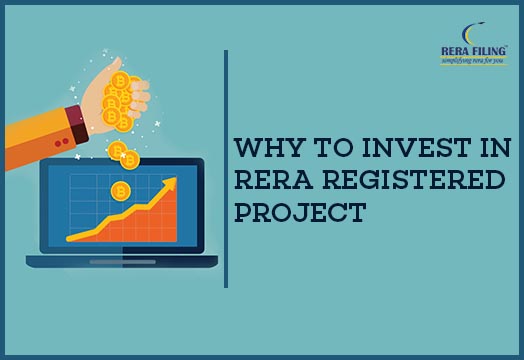Why to invest in RERA registered projects?

- General
- Author: Shreya Uppal
Highlights
We all are truly aware of the main motive of the introduction of the RERA Act, 2016 is to protect the homebuyers, infuse transparency into the real estate sector and provide speedy dispute redressal for the consumer grievances.
However, there can be some more reasons to invest in the RERA Registered projects which are described below:
Now, with the introduction of the RERA Act, 2016 which has specifically defined the carpet area and its calculation, the manipulations can be avoided.
We all are truly aware of the main motive of the introduction of the RERA Act, 2016 is to protect the homebuyers, infuse transparency into the real estate sector and provide speedy dispute redressal for the consumer grievances. However, there can be some more reasons to invest in the RERA Registered projects which are described below:
1. Some of the provisions of the RERA Act, 2016, clearly defines the documents that are to be attached by the promoter while registering its project and which calms the homebuyers from the tensions of all the security issues.
(a) Section 4 of the RERA Act, 2016 makes it compulsory for the promoter to attach documents like Land Approval, Allotment letter, which defines the proforma of allotment letter, agreement for sale and the conveyance deed to be signed with the allottees, which naturally bind the developer to provide all these to the homebuyer. A provision in the law makes it more valuable to provide it with the same.
(b) In order to provide reliability of the developer involved, information like, brief details of the projects launched by the developer in the past 5 years, whether already completed or being developed, its completion and pending cases against him have also been asked by the developer while submitting the registration application as per Section 4 of the RERA Act, 2016.
2. To secure the money invested by the homebuyers in their respective projects, a provision has been inserted in the Section 4 (2)(I)(D) of the RERA Act, 2016, which states that the 70% of the amount realized for the real estate project from the allottees shall be deposited in a separate account to be maintained in a scheduled bank to cover the cost of construction and the land cost and it shall be used for that purpose only.
Many cases have been found in various states where the developers are violating this provision and using this separate account money to pay their bank loans and being penalized for the same.
3. Section 11 of the RERA Act, 2016 defines the duties of the promoter which lawfully binds the promoter to follow these below-mentioned duties and relieves the buyers from the hassles of the property dealings which are:
(a) execute a registered conveyance deed of the apartment, plot or building, as the case may be, in favor of the allottee along with the undivided proportionate title in the common areas to the association of allottees or competent authority, as the case may be, as provided under section 17 of this Act.
(b) be responsible to obtain the completion certificate or the occupancy certificate, or both, as applicable, from the relevant competent authority as per local laws or other laws for the time being in force and to make it available to the allottees individually or to the association of allottees, as the case may be.
4. Standardized Carpet Area
Earlier the carpet area on which the developer used to calculate the property price was not defined anywhere. As a result of which every promoter used to calculate the property rates using his own calculation method for the carpet area. The direct impact of the inflated Carpet area calculation was on the property prices which used to shoot up immediately.
Now, with the introduction of the RERA Act, 2016 which has specifically defined the carpet area and its calculation, the above can be avoided.
5. Parity of rate of Interest on default
Before the introduction of the RERA Act, 2016, there was no parity in the rate of interest on default of the payment. The RERA Act, 2016 has specifically stated that the interest rate should be the same for both the parties. The interest paid by the buyer in case of default of payment was much higher than the rate of interest paid by the builder on the delayed possession of the property.
6. As per Section 13 (1) of the RERA Act, 2016, a promoter cannot accept more than 10% of the cost of the apartments as advance or application fees, before entering into an agreement for sale. With this clause, the buyer has been safeguarded against many malpractices which were used to happen.
7. Rights of the buyer
(A) In case of Delay in possession: The buyer can either withdraw from the project, wherein he shall be entitled to get the full refund amount along with the interest payable from the due date of the completion till the amount gets refunded or he can continue with the project, where he will get the compensation amount along with the interest payable till the completion date.
(b) In case of Defects after possession
As per section 14 (3) of the RERA Act, 2016, any structural defect or any defect in workmanship, quality, or service is discovered within the 5 years after the possession of the apartment, such defect shall be rectified by the builder without any cost within 30 days. Failing to do the same, the buyer shall be entitled to claim the compensation.
8. As per Section 12 of the RERA Act, 2016, where any person makes an advance or a deposit on the basis of the information contained in the notice advertisement or prospectus, or on the basis of any model apartment, plot or building, as the case may be, and sustains any loss or damage by reason of any incorrect, false statement included therein, he shall be compensated by the promoter.
For Project Registration, Click here.
Tags: Allotment letter, separate account , structural defect , carpet area
Latest Blogs
- Rights of buyer under RERA
- Delhi RERA Agent Procedure for Re-validation or Renewal
- MahaRERA guidelines for Real Estate agent training and certification
- Force Majure Clause in RERA
- All you need to know about Relinquishment Deed
- RERA Agent Renewal in Maharashtra
- What is Title Verification and Search Report?
- Revocation under the RERA Act
- RERA Limitations
- Homebuyers right in case of insolvency
Copyright © 2023 RERA Filing. All rights reserved.
 Rera
Act
Rera
Act
 Maharashtra
Maharashtra Karnataka
Karnataka Andhra Pradesh
Andhra Pradesh Uttar Pradesh
Uttar Pradesh